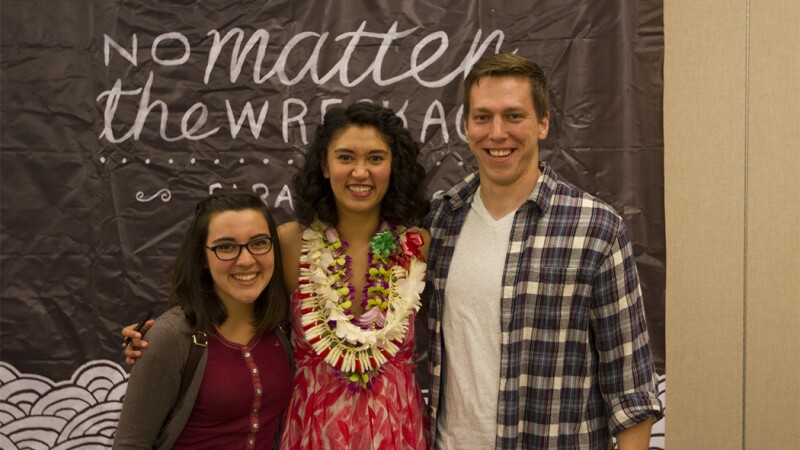Famous spoken-word poet Sarah Kay visited ‘Iolani School in Honolulu as part of her tour for her book, “No Matter the Wreckage.” Some BYUH students made the journey to town to see the poet perform live and ask her to sign their books. Ryndan and Kayla Riley, sophomores from Nevada, have been fans of Kay’s “for a while.” Ryndan introduced Kayla to Kay’s work when they were dating. The Rileys agreed it was worth it to drive to Honolulu to see her perform.Ryndan said getting to experience her art in person was memorable. “She’s a very talented spoken word artist; unlike most spoken word artists, she focuses on positive things in her poems. That’s what separated her from other artists for me. She’s very talented; she can write about pretty much anything and still make it beautiful and poetic,” Ryndan said. Kayla said she also enjoyed Kay’s performance because Kay made it personal. “She has a great personality. When she was signing my notebook, she drew me as the sunset and she drew Ryndan as an elephant. I just thought that was hilarious. What an awesome person,” Kayla said, laughing. BYUH student Lana Harris-Pitts agreed with Kayla. “Sarah is great! It was just unreal that she was actually here in Hawaii and we met her. I’m used to watching her on YouTube so it was crazy seeing her in person.” The Ke Alaka’i was also fortunate enough to interview Kay over the phone the morning of her performance in Honolulu. Sarah Kay started performing poetry when she was 14, but her passion for it started way before then. Little Kay would run around the house yelling “poem!” at her mom before she knew how to write. Kay would dictate poems and have her mother write them down for her.Kay’s parents fueled her passion for poetry during early elementary school. Everyday, her parents would write a little poem and put them in her lunch. For Kay, it became something that she looked forward to every day, and got her excited about poetry. “It felt like a gift,” Kay said, “Those things carried on to how I feel about poetry now.”Kay said that she learned how to write poetry based on how her father taught her how to take pictures. “When my dad photographs he always says to look for where the light is, find the light and follow the light. He tries to capture specific moments that are full of color, shape and light.” Kay continued to relate those lessons to her poetry. “When I think about poetry I’m often trying to capture a specific moment or specific scenes much in the same way that he tries to capture when he’s photographing.” Kay’s brother has also been the inspiration of some her poems. “I adore my brother. He is my best friend and my hero,” Kay said smiling. “I’m always amazed by him, but he also is my grounding force; he is my anchor and he probably reflects my poetry much more than he would care to admit or know about.” Kay’s brilliance is inspirational and admirable to BYUH students. Her advice to fellow writers of any level was to not let the fear of writing a “bad” poem stop you. Kay said, “It’s going to happen. In varying degrees of badness. So worrying about it is a waste of your energy. It’s okay to write a bad poem, it’s okay to write a mediocre poem, you have to write through bad and mediocre poems to get any better.” Kay continued to give advice to writers when they get stuck. “With writing, it isn’t just some people are born with it and some people are not; I guess sometimes that happens, but more often its you want to get better so you work at it. You write something, you write drafts, you edit, you ask people to look at it. It’s a process. So don’t be scared of writing dead poems. Write them. Then write a little bit better and a little bit better.” When asked how Kay writes her poetry, she said that she keeps track of peculiar moments in a notebook to use when she sits down to work on a poem. “I keep track of moments that are important, titillating, exciting or weird. I keep them in a notebook, then, as I go, I have this collection of thoughts or words that have mattered to me in various degrees and I make time to actually sit down and try writing, and when I sit down to try to write, I have this series of notes that I’ve made for myself so that I’m not trying to fabricate inspiration in the moment. I can follow a Hansel and Gretel bread crumb trail back to moments when I was genuinely, authentically moved by something.” Along with keeping these moments in a notebook, Kay uses poetry as a way to figure things out that she doesn’t quite understand. “When I have something that puzzling over when I have something that I can’t quite wrap my head around I’m having trouble understanding, I use poetry as a way to help me navigate those questions.” An example of this process in Kay’s life goes back to her brother. Kay used her poem “Ghost Ship,” to try and figure out her brother. “Now a days I’ve been watching him trying to figure out what it means to become a young man and the demands and expectations that men and women hold for each other,” Kay continues, “Ghost Ship is my way of both trying to understand those demands that we make on both genders and also specifically my little brother and his maneuvering on how to become a man in this world.” Uploaded Feb. 18, 2015.
Writer: Kaitlin Broyles

